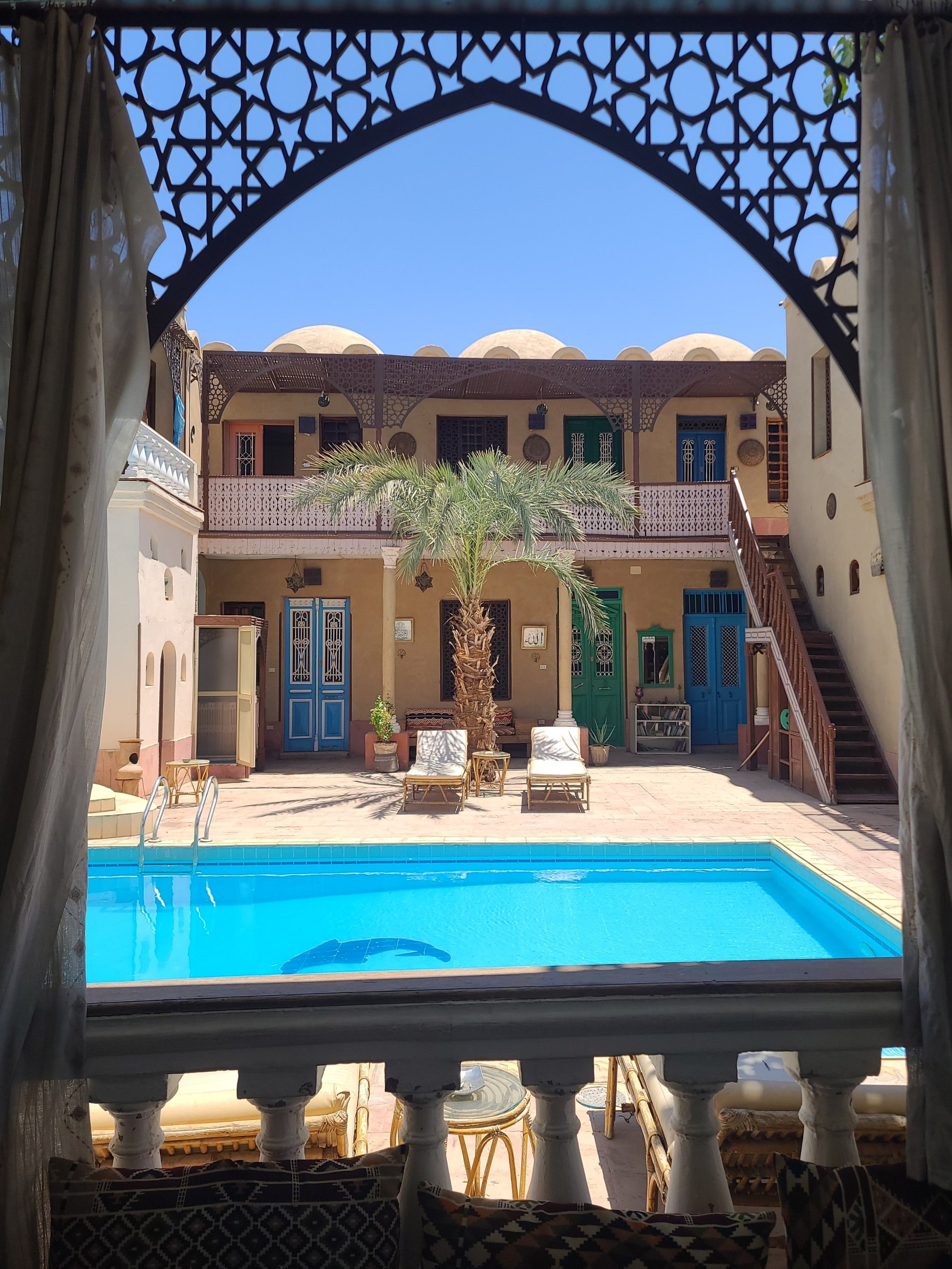The tranquility of Luxor is a welcome relief after the hustle and bustle of Cairo, especially on the West Bank, away from the downtown and touristy areas. The morning call to prayer wakes me just before dawn, when the air is still and cool. From the rooftop terrace of the hotel I can look out over the Nile, watching colorful Dahabiya boats crisscross the blue waters. On the opposite bank, I can see the towers of Luxor Temple, juxtaposed with the Winter Palace, a colonial-era palace now turned 5-star hotel.
On the street, I’m greeted by the smell of sunbread rising outside mudbruck houses, of meat and beans cooking, diesel, livestock, and burning trash. Niqāb-clad women in twos and threes sit chatting on doorsteps and children wave at us as we ride by. Donkey-carts are an almost-as-popular form of transportation as cars in the narrow, dirt-packed village streets. Colorful streamers left over from Eid celebrations canopy the span between buildings, and colorfully-decorated walls proudly proclaim which households have made the hajj, the Muslim pilgrimage to Mecca.
Further from the Nile, the villages give way to fertile fields full of wheat, sugarcane, bananas, beans, alfalfa, and more I can’t identify. Men work the fields with the help of donkeys and water buffalo, in many areas farming the same way they have here for thousands of years. In ancient times, the Nile flooded annually, believed to be the tears of the goddess Isis, but since the 1902 completion of the Aswan Dam, the waterflow is now controlled and the river remains within its banks.
My hosts in Luxor are Annmarie (American) and Ganun (Egyptian), a couple who have made it their mission to rescue and rehabilitate abused horses in Egypt, which are far too common. Their stable is just a block from the banks of the Nile, painted with colorful hieroglyphs, and home to around 20 horses they have rescued so far. Some will be our mounts for the week, others are still being nursed back to health. A combination of Arabians, Baladi, and Arabian-crosses, the horses are enthusiastic and energetic but remarkably calm in the face of motorcycles careering around corners in the narrow streets, donkey carts piled meters high with straw and wheat, and children running and yelling through the streets.
We ride from the village to the temples of the West Bank, found at the edge of the fields where farmland meets desert. In ancient times, the floodwaters came all the way to these sites, allowing the Egyptians to unload stone quarried from Aswan and brought down the river. At Habu Temple and Rammseum, I dismount and meet our guide, Mohammed, or “Professor Egypt,” I call him. He’s an Egyptologist, incredibly knowledgeable, and his passion for Egyptian history is almost tangible. Over the course of the week, he will guide us through the sites and history of Luxor, from Karnak and Luxor Temple on the East Bank to Hatshepsut Temple and Valley of the Kings in the west. He speaks as if he knew the ancient kings and queens personally, recounting their lives like gossip. At the tombs, where guides cannot enter, he sends us ahead to “meet the king,” and tells us to “say hello to him for me.”
Each day we ride through different parts of different villages and Ganun tells us about the differing cultures from one village to the next - his village is more focused on tourism, the next one on farming, and the next one prides themselves on their cattle. He points out new archeological sites where a village has been unearthed beneath what used to be a field where he played soccer growing up, until someone discovered an underground chamber full of golden treasures. On a nearby hillside, his grandparents used to live in a village where the homes were built on top of ancient tombs, using the emptied burial chambers as rooms. Once the burial sites were “discovered,” the villagers were forced to move. Everywhere we look, ancient Egypt continues to affect the daily lives of the locals, whether by shaping the landscape where they now live or bring the tourists who now feed their economy.
The late afternoons often find us at the edge where farmland meets the desert, the setting sun casting us in a golden glow from behind the distant mountains, the soft sand perfect for long gallops.
We spend one lovely evening on board a dahabiya, one of the colorful boats found up and down the Nile which act as water taxis, dinner cruises, party boats, and more. We watch the sun set over the slowly rising river - it will reach its high point in just a few weeks before starting to recede again towards the end of summer.
The morning before we all part ways, we take the horses for a swim in the Nile, which is almost at its high point. Dahabiya boats, felucca sailboats, and cruise ships sail by as we ride bareback through the warm water, tall grass tickling our toes. I look forward to my next visit - exploring more ancient wonders in the area and seeing the progress the latest rescues have made.












